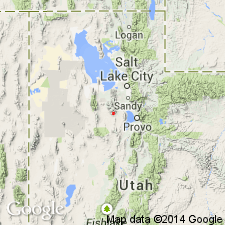
- Usage in publication:
-
- Big Cottonwood quartzite series
- Modifications:
-
- Original reference
- Dominant lithology:
-
- Quartzite
- AAPG geologic province:
-
- Southern Rocky Mountain region
Summary:
Pg. 362. Big Cottonwood quartzite series. Term applied to basal quartzite series of Wasatch Mountains, consisting of 12,000 feet of Cambrian [and pre-Cambrian(?)] quartzites with clay slates at top, underlying Silurian Ute limestone [broad sense of King].
[See also S.F. Emmons IN U.S. geological exploration of the Fortieth Parallel, Clarence King; Pt. 2, Descriptive geology, p. 229-230, 357, 358, 366.]
Source: US geologic names lexicon (USGS Bull. 896, p. 182).
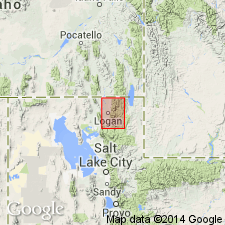
- Usage in publication:
-
- Big Cottonwood series
- Modifications:
-
- Overview
- AAPG geologic province:
-
- Southern Rocky Mountain region
Summary:
Pg. 1130 (table). Table of summary of formations in Logan quadrangle, Utah, lists Precambrian Big Cottonwood series below Cambrian Brigham quartzite.
Source: US geologic names lexicon (USGS Bull. 1200, p. 330-331).
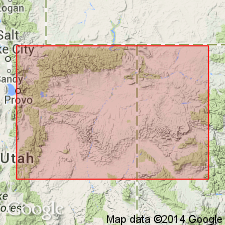
- Usage in publication:
-
- Big Cottonwood formation*
- Modifications:
-
- Overview
- AAPG geologic province:
-
- Southern Rocky Mountain region
Summary:
Pg. 61-65. Big Cottonwood formation. Consists of white or greenish quartzite and brown, green, or deep-blue-purple shale or slaty shale. Thickness 12,000 to 16,000 feet. Underlies unnamed tillite [?Tintic formation]; unconformably overlies "the Metamorphic complex." Age is Precambrian.
Source: US geologic names lexicon (USGS Bull. 1200, p. 330-331); GNC index card files (USGS-Menlo).
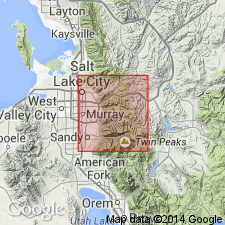
- Usage in publication:
-
- Big Cottonwood series
- Modifications:
-
- Overview
- AAPG geologic province:
-
- Southern Rocky Mountain region
Summary:
Pg. 3-4, pl. 1. Big Cottonwood series. Term is here proposed for 16,000-foot sequence of alternating rusty-weathering white or greenish quartzites and variegated red, greenish, and blue-purple shales that crop out in lower gorge of Big Cottonwood Canyon. Is ripple marked and cross-bedded. Has mudcracks and shale-flake conglomerates. Probably deposited in shallow water. Shale units are 50 to 200 feet thick and can be traced over distances of several miles suggesting a broad, gradually subsiding embayment, rather than a fluviatile or floodplain environment. Except where heated by Little Cottonwood stock, is no more indurated than overlying Cambrian. Unconformably overlies Little Willow series (new); underlies Mineral Fork tillite (new). Probably correlates with thick quartzite and shale of the Uinta Mountain group. Age is Precambrian. Report includes geologic map.
Source: US geologic names lexicon (USGS Bull. 1200, p. 330-331); supplemental information from GNU records (USGS DDS-6; Denver GNULEX).
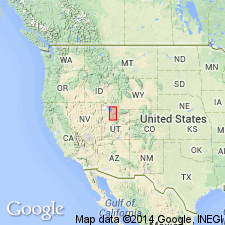
- Usage in publication:
-
- Big Cottonwood series
- Modifications:
-
- Areal extent
- AAPG geologic province:
-
- Southern Rocky Mountain region
Summary:
Pg. 36, 37 (fig. 2). Big Cottonwood series. Discussed in Uinta-Wasatch Mountain junction and part of central Utah. Diagram shows Big Cottonwood above Little Willow series and below Mineral Fork tillite and Mutual quartzite in Wasatch Mountains and below Sheeprock series in Sheeprock Mountains. Correlates with Uinta Mountain group in eastern Uinta Mountains. Age is Precambrian.
Source: US geologic names lexicon (USGS Bull. 1200, p. 330-331).
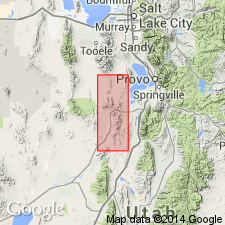
- Usage in publication:
-
- Big Cottonwood formation*
- Modifications:
-
- Overview
- AAPG geologic province:
-
- Southern Rocky Mountain region
Summary:
Big Cottonwood formation. Present in low foothills at head of Tintic Valley, Utah. Shown on geologic map in Slate Jack Creek, in T. 11 S., R. 1 W., Utah County, Utah. Partial section 1,673 feet thick measured in E/2 sec. 3, T. 10 S., R. 3 W., Juab County, Utah. Recognized and defined by its position above crystalline rocks and below tillite (both Precambrian). However no tillite present in report area. Age is late Precambrian. Report includes correlation diagrams.
Source: Modified from GNU records (USGS DDS-6; Denver GNULEX).
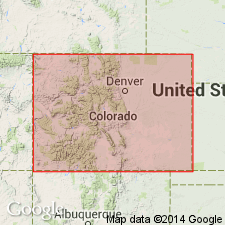
- Usage in publication:
-
- Big Cottonwood Formation*
- Modifications:
-
- Age modified
- AAPG geologic province:
-
- Southern Rocky Mountain region
Summary:
Big Cottonwood Formation. Present in the southern Wasatch Mountains, Salt Lake County, Utah. Has been considered a western extension of Uinta Mountain Group. Quartzite is identical in appearance to quartzite of the Uinta Mountain. However, outcrops are discontinuous and these two units have no distinctive horizons for physical correlation. Paleomagnetic studies show a shallow magnetic inclination and normal polarity similar to that of main body of Uinta Mountain Group and to Galeros Formation of Chuar Group. Age is early Late Proterozoic, based on its relationship to the Uinta Mountain Group which carries lower Upper Proterozoic CHUARIA-bearing acritarchs and vase-shaped chitinozoan-like microfossils. Report includes correlation chart, stratigraphic charts.
Source: Modified from GNU records (USGS DDS-6; Denver GNULEX).
For more information, please contact Nancy Stamm, Geologic Names Committee Secretary.
Asterisk (*) indicates published by U.S. Geological Survey authors.
"No current usage" (†) implies that a name has been abandoned or has fallen into disuse. Former usage and, if known, replacement name given in parentheses ( ).
Slash (/) indicates name conflicts with nomenclatural guidelines (CSN, 1933; ACSN, 1961, 1970; NACSN, 1983, 2005, 2021). May be explained within brackets ([ ]).

